Coffee in Italy is a culture you must taste to understand
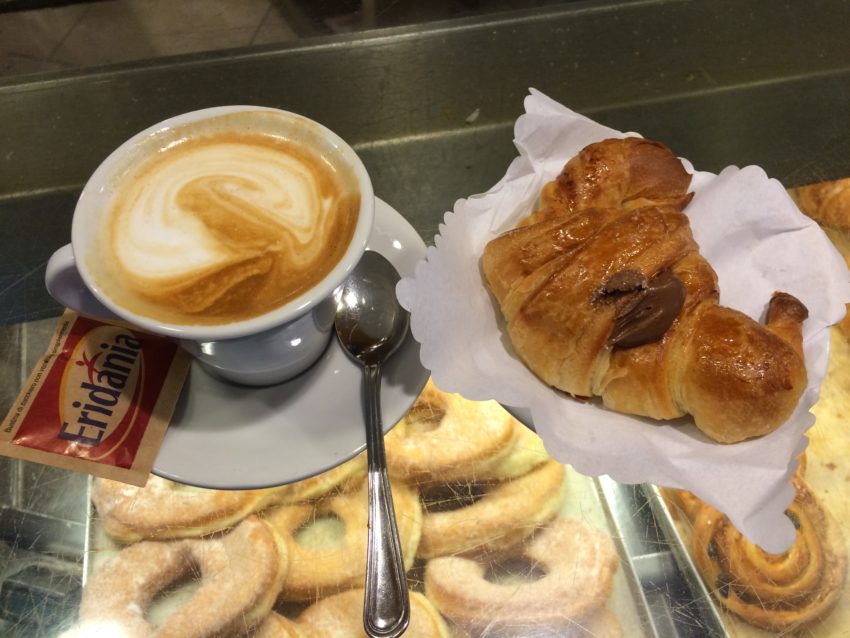
I once had a friend who worked for Vatican Radio and had one of the greatest handicaps for living in Rome. She was allergic to dairy products. Think about it. She couldn’t eat cheese. She couldn’t eat gelato. How can you live in Rome and not eat cheese or gelato? It’s like moving to the Caribbean and not being able to swim. I mean, what’s the point? Then again, when I moved to Rome, I had a big handicap, too, one that made Italians look at me as if I had a third eye.
I didn’t drink coffee.
I wasn’t allergic to it. I hated it. I loathed it. I didn’t like any hot liquids. Hot chocolate. Saki. Hot spiced wine. But coffee topped the list of disgusting beverages. Bitter and drab, it did nothing but make me thirsty. And I viewed all fluids as a means to quench a thirst. Nothing else. During an all-night writing marathon, caffeine had all the effect on me as Pez.
When I moved to Rome the first time in 2001, I made a tough decision. I love hanging out in piazzas. They are what separates Rome from every city in the world. It’s what makes living in Rome like living in a small town with a big city right across the street. I also love wine. But drinking wine all day in a piazza is problematic. I wasn’t a bored housewife in the suburbs.
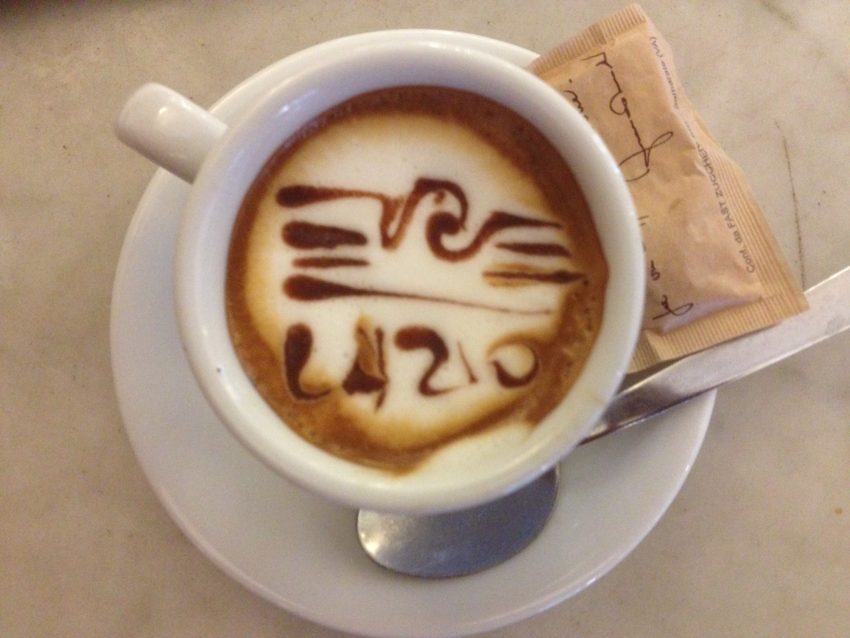
I decided I’d better start drinking coffee. I’d better learn to like it. I remember my first cup of coffee in Rome. My then-girlfriend and I had just landed in November 2001 and we checked into a hotel by the Termini train station. We walked a couple blocks to tree-lined Via Merulana, one of Rome’s prettiest streets. We went to Caffe Merulana and I ordered a cappuccino. The waiter brought it out and in the foam, the barrister had artfully formed a heart. The first sip was like a child eating his first piece of chocolate. Creamy. Sweet. Warm. The milky froth took off just enough bitterness and the sugar added just enough sweetness to make it more of a dessert than a caffeine jolt. The heart in the foam became quite an omen.
The relationship didn’t last but my love for coffee sure did.
Now every morning I dive head first into a coffee culture that is as much a part of the Italian social fabric as aperitivos, wine and corrupt politics. When I wake, pure muscle memory pulls me into my kitchen where I take my little espresso maker and make a cappuccino that is always percolating right when my computer is warmed up. I take my cappuccino onto my terrace, look out over the Tiber River and the foamy milky coffee reminds me of why I love living in Rome so much.
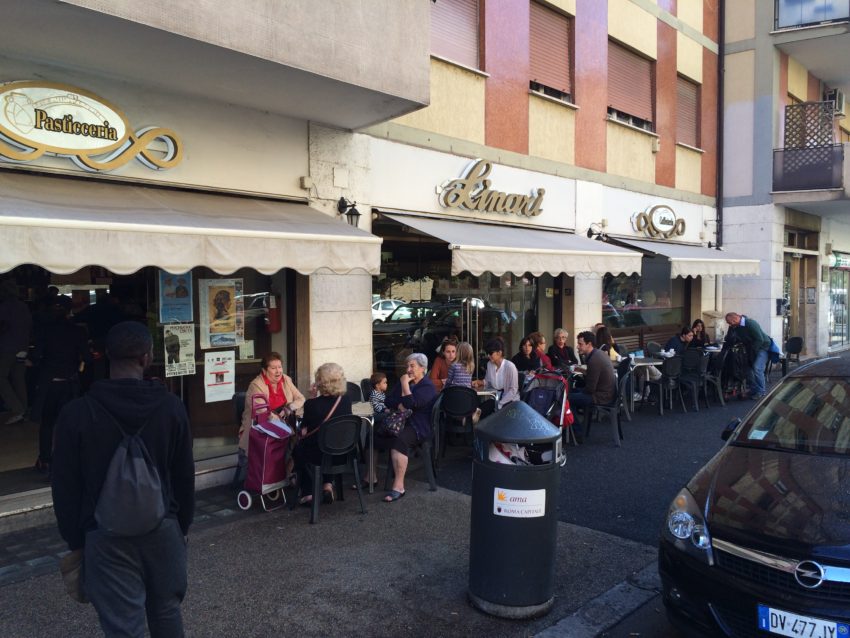
Three or four times a week I’ll walk two blocks to my local cafe, Linari, and stand at the counter with a cappuccino and a perfect chocolate cornetto. If I stay long enough I’ll probably see more than half my Testaccio neighborhood, all gossiping away in the Romanaccio version of Italian that I have no hope of ever understanding.
To live in Italy, one must do more than drink coffee. One must understand coffee. When you visit Italy, order a coffee in one of the following ways:

Caffe. This is the most common yet the most shocking to Americans. It is a simple shot of espresso that fills about a third of a small cup just a bit bigger than a thimble. I still enjoy watching Americans’ jaws drop when they see it and ask, “Where’s the rest of it?” This isn’t Starbucks, Bubba. Thank God.
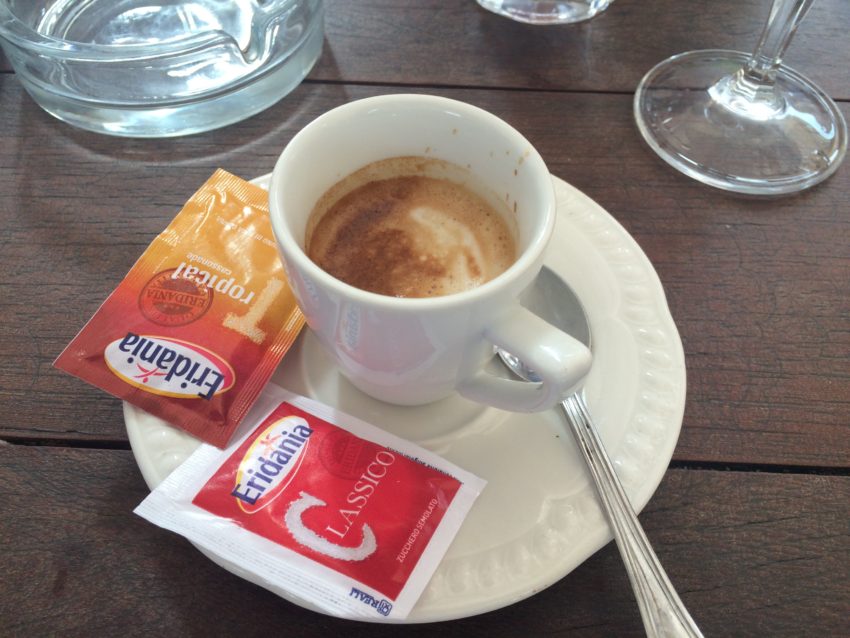
Caffe macchiato. This is halfway between a caffe and a cappuccino. It’s a caffe stained with a little spot of milk. Pronounce it correctly, mock-ee-OTTO, and you’ll be treated like a local.
Cappuccino. The classic Italian coffee. Espresso coffee covered in warm milk then topped with creamy foam, it is the perfect way to start the Italian day. Please note the word “start.” Do NOT, even if the craving eats at you like a heroin withdrawal, order a cappuccino after noon. Only tourists do that. Yes, you’re a tourist. Just don’t act like a stupid one.
Cappuccino ben caldo. “Ben caldo” means “extra hot.” This is my favorite. Italians like to drink their coffee fast and don’t like it so hot it singes their tongues like American coffee. I like mine with a newspaper.
Marochino. A small cappuccino sprinkled with chocolate, popular with Italian teen-agers and wimpy American expats.
Ristretto. A shorter, very strong shot of espresso and isn’t much more than a sip. It should not be confused with ristretto’s other meaning: What happens to a man’s penis when he comes out of the cold Adriatic Sea.
Americano. A long black coffee that, in more than three years in Rome over two stints, I have never seen an Italian order unless he lost a bet.
It’s a long list. (In fact, check out these gift ideas for Italian coffee lovers at the website 1MillionGiftIdeas.) However, the long list above is nothing compared to that bastion of bad taste, that despicable, grotesque coffee stain on the international coffee landscape.
Starbucks.
A big reason I once thought of drinking coffee in the same terms as drinking snake blood is Starsucks. Its coffee is as bitter as a Hollywood divorce and nearly as expensive. Its coffee menu is longer than Denny’s. Yes, it’s a nice variety but the recipes were contrived in a corporate office in Seattle. Italian coffee has been passed down from generations since it arrived in Venice in the mid-16th century. Go ahead. Walk into a rough-and-tumble bar in Rome and order an “iced, half-caff, ristretto, venti, four-pump, sugar free, cinnamon, dolce soy skinny latte.” (Yes, someone at Starsucks really ordered this once.) You’ll get tossed out right onto your Yankees cap.
My biggest problem with Starsucks is it has ruined nearly as many neighborhoods as crack houses. Starsucks is the Walmart of cafes. Cafes should have a family feel. Each should be different. They should be warm, cozy, with the atmosphere that makes you want to stay and chat or read for a few hours. Starsucks came into my old neighborhood in Denver and bought out the one local cafe down the street. The friendly barrister was replaced by a gum-chewing college-age chick with an attitude as bad as her haircut.
Starsucks isn’t about culture. It’s about profits. They want turnover. It’s why its chairs are so uncomfortable, an Indian fakir couldn’t sit in one more than 15 minutes. Starsucks are like Marriott hotels. Every one looks the same from Barstow to Bangkok. Italy, God love it, told Starsucks it could not open a franchise here. It’s the best decision Italy’s made against American culture since outlawing guns.
If you live in Italy — even if you visit — the first thing you must do is establish a local cafe. It’s where every Italian’s day begins. It’s a slice of true Italian culture as genuine as a British pub. You chat with the owner and your favorite barrista. You pick up a spare newspaper lying around and bitch to the guy next to you about A.S. Roma’s last heartbreaking loss.
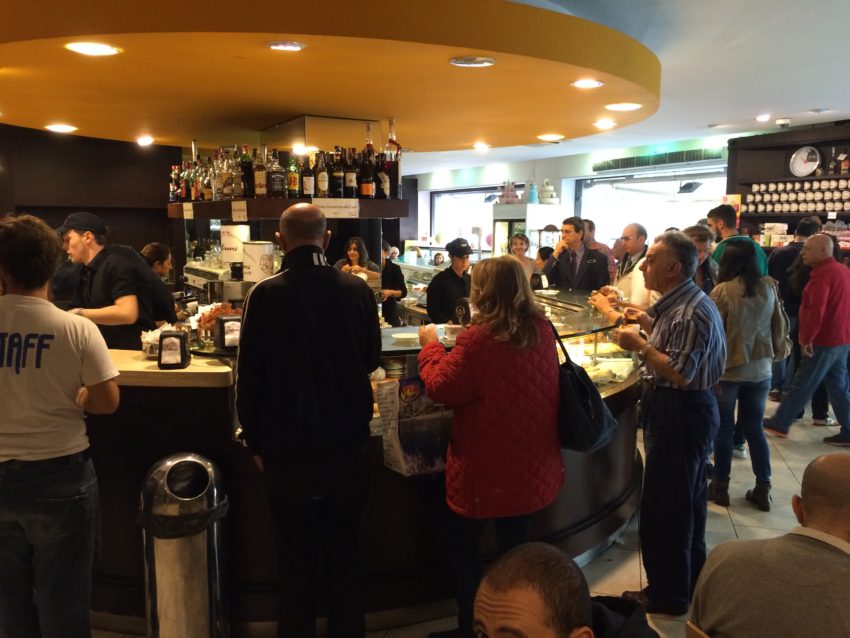
My home away from home is Linari. It is labeled a pasticceria, a pastry shop, and the display cases would make a 5-year-old’s mouth water. Cannoli. Chocolate layer cakes. Cookies. Chocolate biscotti. Eau claires. Gelato. And they have the best cornettos in Rome. A cornetto is basically an Italian croissant filled with chocolate, cream or marmalade. They also have plain, or, simplice. The staff all know my name and don’t even bother looking at my receipt order. They automatically put out two small plates in front of me on the counter. They put a frothy, creamy cappuccino on one and take a cornetto to the back where they fill it with a shot of warm Nutella, the famed, 70-year-old chocolate spread Italians eat like peanut butter. The pastries here are so good it’s part of Testaccio’s gastronomic tour.
Linari was established in 1971 by Giancarlo Linari. He died a couple of years ago and handed it over to his two daughters and two sons. Unlike many cafes where people down a quick espresso and bolt, Linari could be an Italian word for “linger.” I often would get my Corriere dello Sport or La Gazzetta dello Sport newspapers and take my cornetto and cappuccino to one of the outdoor tables. I’d sit with the neighborhood’s old ladies and mechanics and middle-aged beauties and read, eat and sip in the sun.
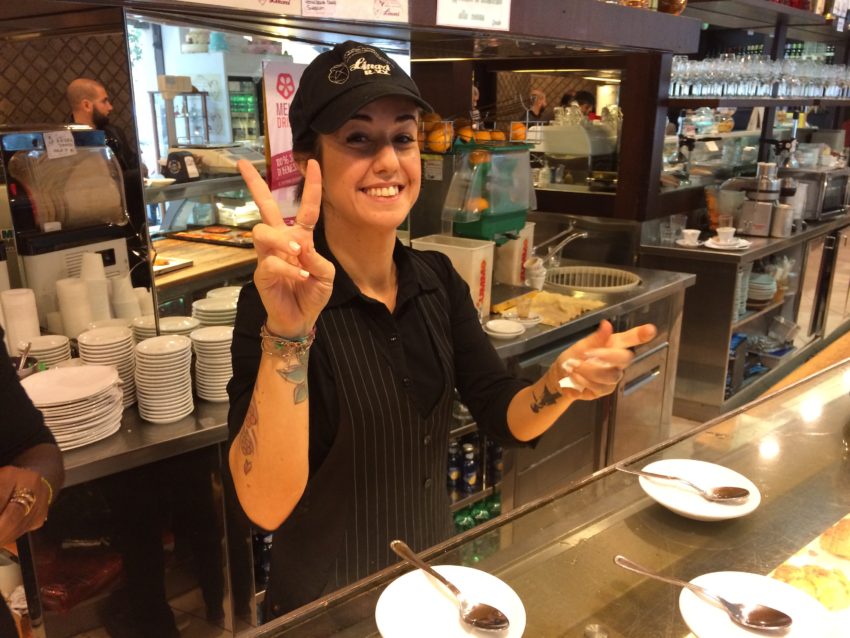
Try doing that at a Starbucks in Des Moines.
Rome has fierce competition about where to find the best coffee. I put Linari at the top of the list — until one day. I read in The New York Times that the best cappuccino in the world is at Tazza d’Oro (Cup of Gold), near the Pantheon. I don’t like The New York Times. I find it stuffy, heavy handed and elitist. It’s 3 euros for 18 pages. Last month it did a four-page special section on the Singapore Grand Prix, just to appease its wealthy advertisers who follow Formula I. Come on! However, I had to see how far off The Times was on its cappuccino rating. I visited Tazza d’Oro shortly after I returned to Rome last year and I must say …
… The Times was spot on.
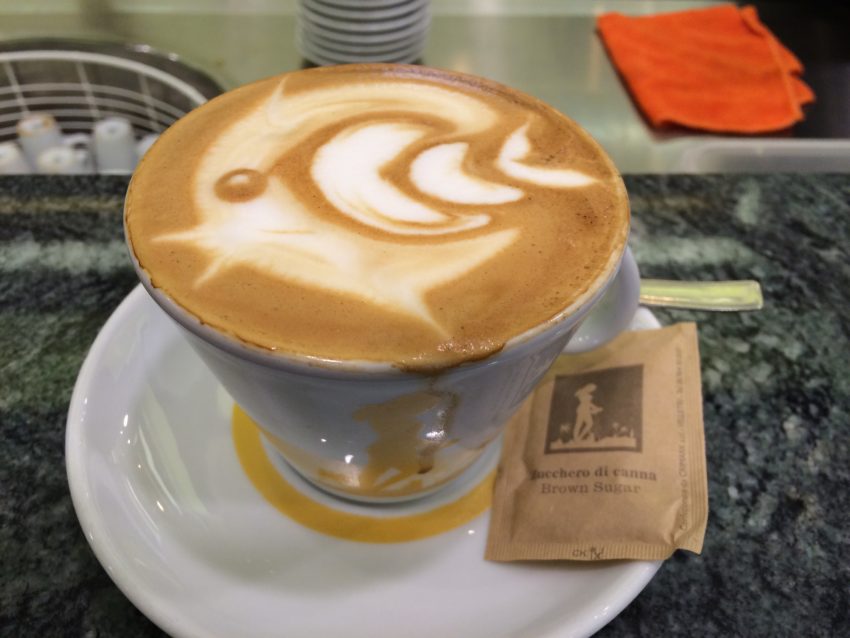
Tazza d’Oro’s cappuccino is creamier, richer, sweeter and more luscious than any I’ve ever had. Every time I go back I swoon like I’m drinking it in bed with a beautiful woman and not with a pack of Japanese tourists. It’s also only 1.10 euro. Tazza d’Oro is a beautiful cafe. It’s a long, bending bar with stained wood paneling and a shop in the back selling Tazza d’Oro coffee to a steady stream of customers. I asked the barrister, a young, burr-cut man what its secret was.
“Nothing,” he said with a shrug as if he’s been asked it numerous times. “Good coffee.”
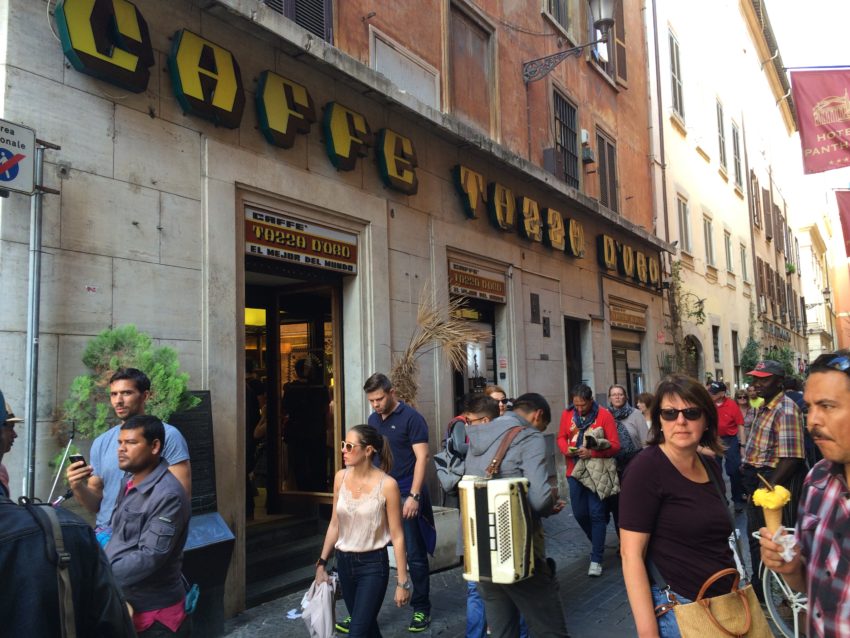
He said they take coffee beans from eight countries in Latin America, from Brazil to Mexico. “And also,” he said with a smile, “I prepared it.”
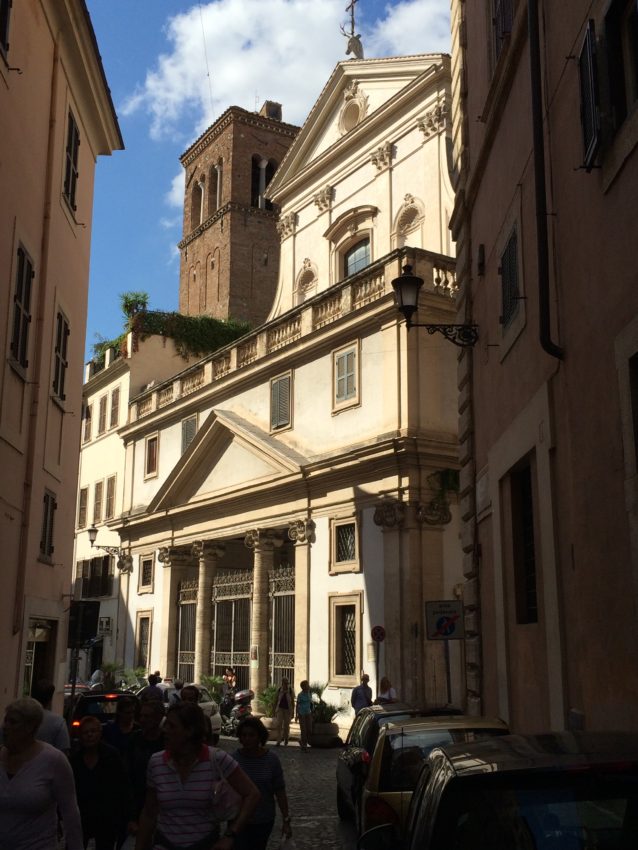
Arguably Rome’s most famous cafe has received more press than Fellini. Caffe Sant’Eustachio opened in 1938 just on the other side of the Pantheon. It was named after Eustace, a general under emperor Trajan in the 2nd century A.D. A pagan, Eustace converted to Christianity one day when he went hunting and saw a vision of a crucifix between a stag’s horns. Sant’Eustachio church, across the piazza from the cafe, has stood for 1,000 years and doesn’t have a traditional cross on top. It has the head of a stag.
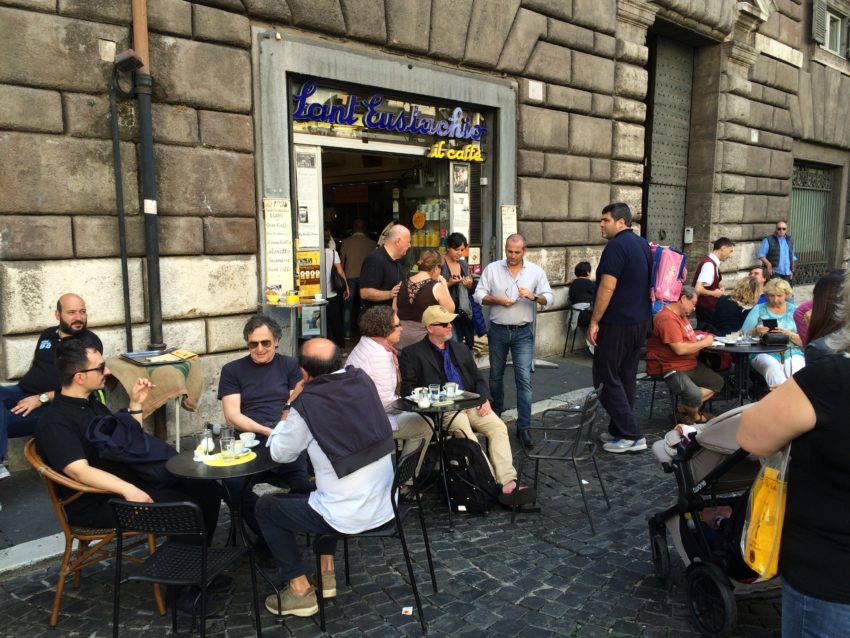
The cafe has numerous outside tables, nearly always full. The inside still has the original mosaics and furniture. It feels like old Rome. However, the surly cashier who took my 1.50 euro for a caffe killed my coffee buzz and so did the barrister who put in sugar instead of allowing me like every other cafe in Rome. The caffe was totally ordinary and I walked out wondering about all the fuss.
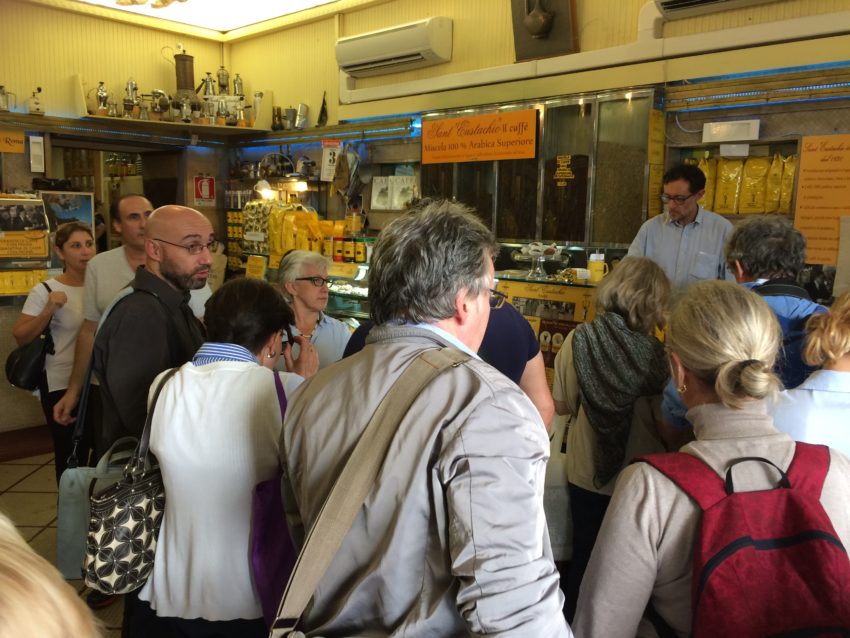
But I understand the fuss about coffee in Italy. La dolce vita isn’t just a lifestyle. It’s a flavor, too. Italy is a country built by conflict, enriched by art and fueled by wine. No matter where you are in Italy, stop. Then smell. Somewhere there’s a cappuccino with your heart in it.


October 7, 2015 @ 6:16 am
Very well researched, John, not only the types of coffee, but the iconic institutions that do them right. This article should be required for anyone who applies for a Permesso di Soggiorno.
October 7, 2015 @ 6:37 am
Thanks, @RickZullo. It means a lot coming from you. Although I wouldn’t mind trying to drink wine in a piazza all day.
October 7, 2015 @ 9:07 pm
That was a thoroughly enjoyable read. Only problem is I’m now craving a delicious cappuccino, but it’s 11 pm. Not coffee time. Have to wait till morning and then I’m stuck with the best I can do with my nespresso.
I’m looking forward to reading some of your other blog posts. Thanks for sharing.
October 8, 2015 @ 1:49 am
Thanks, Pam, for the kind words. It’s the goal of every writer to make readers smell the flowers, feel the wind and, in this case, smell the coffee, pardon the cliché. The problem with coffee in Italy is it spoils you for the rest of the world. Starbucks now makes me nauseous.
October 8, 2015 @ 2:29 pm
Hey John. It’s been awhile since I’ve had the chance to sit down and read your entire post. This was wonderful! I’m a die-hard Pollyanna and I love all the positivity you shared about Italy. You are such an amazing writer! I could sense everything you wrote about. The smell, taste and feel of Italy. You gave me goosebumps! It made me remember how Italy resonates within me. Always has. Maybe in a past life, I was an Italian race car driver or crushed grapes and hearts at my vineyard. Either way, Italy’s in my blood, I’m certain of it. Underneath all the noise and activity in my life, Italy has always been softly whispering me home. Maybe it’s time I listened.
October 9, 2015 @ 1:07 am
Thanks for the love, Cari. It’s good to hear from you. You sound like you’re going through Italian withdrawals. It’s worse than coming off heroin. It’s much more addicting. Maybe you need to come over for a fix.
October 19, 2015 @ 4:17 pm
I stumbled on Tazza D’oro the first time in Rome; now it’s a ritual: I go first to the Pantheon to pay homage, and then my Tazza fix to ward off jet lag.
Thanks for the article. I enjoyed it. Will be in Rome again in January 2016…and can’t wait.
October 19, 2015 @ 11:28 pm
Thanks for the kind words, Annette. What’s amazing is Tazz d’Oro hasn’t caved into economic pressure and jacked up its cappuccinos to 3 euros like some of the over-priced tourist traps 50 meters away on the piazza. It’s still only 1.10. And the staff is real nice, shocking considering how many people offend local custom and order cappuccino in the afternoon — like me. However, that was STRICTLY journalistic research.
October 22, 2015 @ 7:06 am
Hi John,
very well done.
As an Italian reader (meaning a reader of a very nice language to read regardless of contents – provided it’s well written), I get quickly bored and lose any interest in going any further when reading English texts. I must admit this does not happen with your articles (provided I’m interested in the subject, but that’s how it should be, I assume).